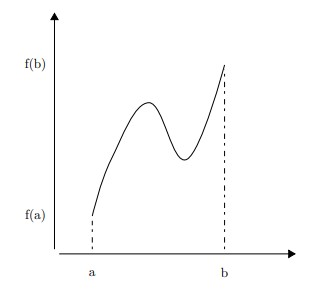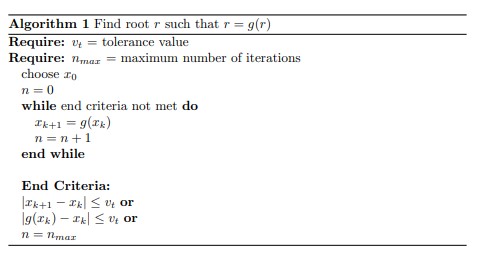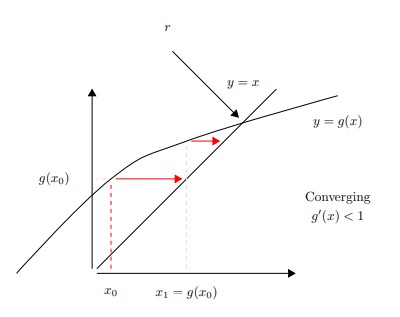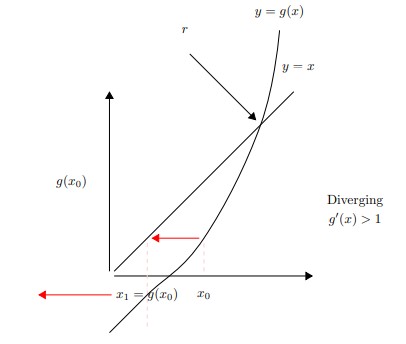Prerequisites
Scalar Product
Consider u,v∈Rd.
The scalar product <u;v> (sometimes written also as u.v) is
<u;v>=d∑i=1uivi
<u;v> is
- Symmetric. <u;v>=<v;u>
- Bilinear.
<λu+μu';v>=λu;v+μ<u';v> u,v,u'∈Rd λ,μ∈R - <z;z>=∥z∥2
Cauchy-Schwarz Inequality
Consider non-zero x,y∈Rn. The absolute value of the dot product;
|<x,y>|≤∥x∥∥y∥
or
|x.y|≤∥x∥∥y∥
the value is equal when x, y are colinear.
Let p(t)=∥ty−x∥2≥0
This value is positive as ∥z∥=√z21+⋯+z2m≥0. Also note by definition of scalar product that ∥z∥=z.z
Hence,
Let p(t)=(ty−x).(ty−x)≥0
using distributive property of dot product
p(t)=ty.ty−x.ty−ty.x+x.x≥0
p(t)=t2(y.y)−2(x.y)t+x.x≥0
if we define;
y.y=a
−2(x.y)=b
x.x=c
then we obtain
p(t)=t2(a)−2(b)t+c≥0
for t=b2a,
p(b2a)=(b24a2)(a)−2(b)(b2a)+c≥0
b24a−b22a+c≥0
−b24a+c≥0
c≥b24a
Hence
4ac≥b2
Therefore, substituting
4(y.y)(x.x)≥[−2(x.y)]2
4∥y∥2∥x∥2≥4(x.y)2
∥y∥2∥x∥2≥(x.y)2
∥y∥∥x∥≥(x.y)
Consider the colinear case if x=cy
| | cy.y | | =c | y.y | |
|---|---|
| =c∥y∥2 | |
| =c∥y∥∥y∥ | |
| =∥cy∥∥y∥ | |
| =∥x∥∥y∥ |
Intermediate Value Theorem
Suppose f is a function continuous in every point in the interval [a,b];
- f will take on every value between f(a) and f(b) over the interval.
- for any value L between the value of f(a) and f(b), ∃c in [a,b] for which f(c)=L

Mean Value Theorem
For f continuous in [a,b] and differentiable over (a,b), ∃c where the instantaneous change is equal to the average change.

hence ∃x such that
f′(x)=f(b)−f(a)b−a
or
f′(x)(b−a)=f(b)−f(a)
Fixed Point Iteration
In solving f(x)=0, we rewrite as x=g(x).
Note This is always possible; f(x)=0
The root r=g(r) where r is a fixed point. Hence with initial guess x0 compute root g(x0). Idea is that x1=g(x0) will be closer to r.
- choose x0
- xk+1=g(xk). Iterate until stop criteria are met.

Convergence Analysis
Let r be a root such that r=g(r). The value of x at iteration step k, xk+1=g(xk).
- The error at step k = & |xk−r|
- The error at step k+1 = & |xk+1−r|=|g(xk)−g(r)|
Considering that the error at step k+1=|g(xk)−g(r)| Using the mean value theorem, there exists point ξ such that,
|g(xk)−g(r)|=|g′(ξ)(xk−r)|
where ξ∈[xk,r]
Note that at each iteration the error xk−r is multiplied by |g′(ξ)|. Therefore,
- if |g′(ξ)|<1 & ek+1<ek & → Convergence
- if |g′(ξ)|>1 & ek+1>ek & → Divergence
Convergence Condition ∃ I=[r−c,r+c] for some c>0 such that |g′(x)|<1 on I and xo∈I
Graphical Approach
Setting y=x and y=g(x), the intersection is the solution as x=g(x)


Example
Solve f(x)=x−cos(x)=0
Solution x=g(x)=cos(x)
Solving to 4 point accuracy, selecting initial guess of x0=1
| x1= | cos(x0)=cos(1)= | 0.5403 |
|---|---|---|
| x2= | cos(0.5403)= | 0.8576 |
| x3= | cos(0.8576)= | 0.6543 |
| … | ||
| x23= | 0.7390 | |
| x24= | 0.7391 |
Therefore r≈0.7391→ Convergent